
Lungfish are freshwater vertebrates belonging to the Superorder Dipnoi. Lungfish are best known for retaining ancestral characteristics within the Osteichthyes, including the ability to breathe air, and ancestral structures within Sarcopterygii, including the presence of lobed fins with a well-developed internal skeleton. Lungfish represent the closest living relatives of the tetrapods. The mouths of lungfish typically bear tooth plates, which are used to crush hard shelled organisms.

Placodermi is a class of armoured prehistoric fish, known from fossils, which lived from the Silurian to the end of the Devonian period. Their head and thorax were covered by articulated armoured plates and the rest of the body was scaled or naked, depending on the species. Placoderms were among the first jawed fish; their jaws likely evolved from the first of their gill arches.
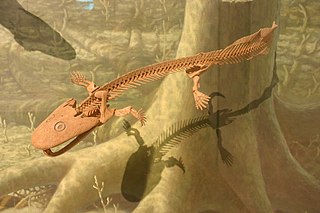
Acanthostega is an extinct genus of stem-tetrapod, among the first vertebrate animals to have recognizable limbs. It appeared in the late Devonian period about 365 million years ago, and was anatomically intermediate between lobe-finned fishes and those that were fully capable of coming onto land.

Dunkleosteus is an extinct genus of large arthrodire ("jointed-neck") fish that existed during the Late Devonian period, about 382–358 million years ago. It was a pelagic fish inhabiting open waters, and one of the first apex predators of any ecosystem.

Panderichthys is a genus of extinct sarcopterygian from the late Devonian period, about 380 Mya. Panderichthys, which was recovered from Frasnian deposits in Latvia, is represented by two species. P. stolbovi is known only from some snout fragments and an incomplete lower jaw. P. rhombolepis is known from several more complete specimens. Although it probably belongs to a sister group of the earliest tetrapods, Panderichthys exhibits a range of features transitional between tristichopterid lobe-fin fishes and early tetrapods. It is named after the German-Baltic paleontologist Christian Heinrich Pander. Possible tetrapod tracks dating back to before the appearance of Panderichthys in the fossil record were reported in 2010, which suggests that Panderichthys is not a direct ancestor of tetrapods, but nonetheless shows the traits that evolved during the fish-tetrapod evolution
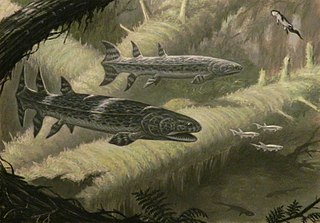
Hyneria is a genus of large prehistoric predatory lobe-finned fish which lived in freshwater during the Devonian period (Famennian).
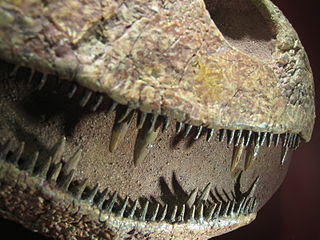
Tristichopterids (Tristichopteridae) were a diverse and successful group of tetrapodomorph fishes living throughout the Middle and Late Devonian. They first appeared in the Eifelian stage of the Middle Devonian. Within the group sizes ranged from a few tens of centimeters (Tristichopterus) to several meters.
Kenichthys is a genus of sarcopterygian fish from the Devonian period, and a member of the clade Tetrapodomorpha. The only known species of the genus is Kenichthys campbelli, the first remains of which were found in China in 1993. The genus is important to the study of the evolution of tetrapods due to the unique nature of its nostrils, which provide vital evidence regarding the evolutionary transition of fish-like nostrils to the tetrapod choanae.

Rhizodontida is an extinct group of predatory tetrapodomorphs known from many areas of the world from the Givetian through to the Pennsylvanian - the earliest known species is about 377 million years ago (Mya), the latest around 310 Mya. Rhizodonts lived in tropical rivers and freshwater lakes and were the dominant predators of their age. They reached huge sizes - the largest known species, Rhizodus hibberti from Europe and North America, was an estimated 7 m in length, making it the largest freshwater fish known.
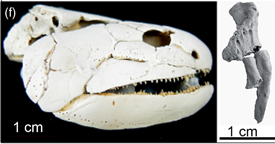
Gogonasus was a lobe-finned fish known from three-dimensionally preserved 380-million-year-old fossils found from the Gogo Formation in Western Australia. It lived in the Late Devonian period, on what was once a 1,400-kilometre coral reef off the Kimberley coast surrounding the north-west of Australia. Gogonasus was a small fish reaching 30–40 cm (1 ft) in length.
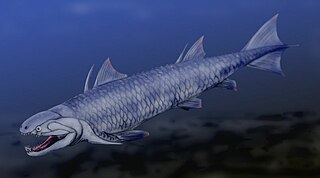
Psarolepis is a genus of extinct bony fish which lived around 397 to 418 million years ago. Fossils of Psarolepis have been found mainly in South China and described by paleontologist Xiaobo Yu in 1998. It is not known certainly in which group Psarolepis belongs, but paleontologists agree that it probably is a basal genus and seems to be close to the common ancestor of lobe-finned and ray-finned fishes. In 2001, paleontologist John A. Long compared Psarolepis with onychodontiform fishes and refer to their relationships.
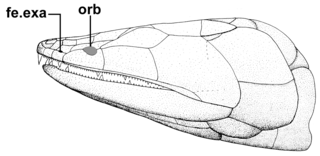
Mandageria fairfaxi is an extinct lobe-finned fish that lived during the Late Devonian period. It is related to the much larger Hyneria; although Mandageria was smaller, it probably hunted in the same way.

Gooloogongia is a genus of prehistoric lobe-finned fish which belonged to the group of rhizodont fishes. Gooloogongia lived during the Late Devonian period. Fossils have been found in the Canowindra site, (Australia). It was named by Zerina Johanson and Per Ahlberg in 1998. In general size and shape Gooloogongia is similar to the modern saratoga which lives in the tropical rivers of northern Australia.

Onychodus is a genus of prehistoric lobe-finned fish which lived during the Devonian Period. It is one of the best known of the group of onychodontiform fishes. Scattered fossil teeth of Onychodus were first described from Ohio in 1857 by John Strong Newberry. Other species were found in Australia, England, Norway and Germany showing that it had a widespread range.

Eusthenodon is an extinct genus of tristichopterid tetrapodomorphs from the Late Devonian period, ranging between 383 and 359 million years ago. They are well known for being a cosmopolitan genus with remains being recovered from East Greenland, Australia, Central Russia, South Africa, Pennsylvania, and Belgium. Compared to the other closely related genera of the Tristichopteridae clade, Eusthenodon was one of the largest lobe-finned fishes and among the most derived tristichopterids alongside its close relatives Cabonnichthys and Mandageria.

Tristichopterus, with a maximum length of sixty centimetres, is the smallest genus in the family of prehistoric lobe-finned fish, Tristichopteridae that was believed to have originated in the north and dispersed throughout the course of the Upper Devonian into Gondwana. Tristichopterus currently has only one named species, first described by Egerton in 1861. The Tristichopterus node is thought to have originated during the Givetian part of the Devonian. Tristichopterus was thought by Egerton to be unique for its time period as a fish with ossified vertebral centers, breaking the persistent notochord rule of most Devonian fish but this was later reinspected and shown to be only partial ossification by Dr. R. H. Traquair. Tristichopterus alatus closely resembles Eusthenopteron and this sparked some debate after its discovery as to whether it was a separate taxon.
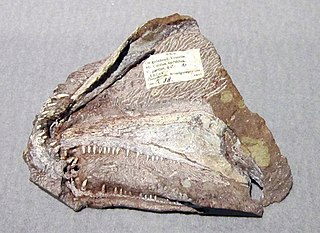
Ymeria is an extinct genus of early stem tetrapod from the Devonian of Greenland. Of the two other genera of stem tetrapods from Greenland, Acanthostega and Ichthyostega, Ymeria is most closely related to Ichthyostega, though the single known specimen is smaller, the skull about 10 cm in length. A single interclavicle resembles that of Ichthyostega, an indication Ymeria may have resembled this genus in the post-cranial skeleton.

Tinirau is an extinct genus of sarcopterygian fish from the Middle Devonian of Nevada. Although it spent its entire life in the ocean, Tinirau is a stem tetrapod close to the ancestry of land-living vertebrates in the crown group Tetrapoda. Relative to more well-known stem tetrapods, Tinirau is more closely related to Tetrapoda than is Eusthenopteron, but farther from Tetrapoda than is Panderichthys. The type and only species of Tinirau is T. clackae, named in 2012.
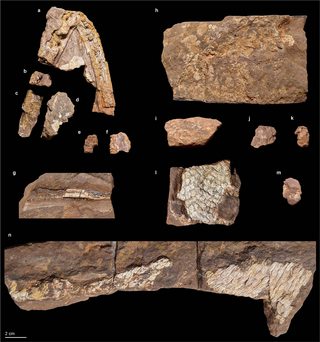
Qikiqtania is an extinct genus of elpistostegalian tetrapodomorph from the Late Devonian Fram Formation of Nunavut, Canada. The genus contains a single species, Q. wakei, known from a partial skeleton. Analysis of the fin bones suggests that Qikiqtania was well-suited to swimming, and likely incapable of walking or supporting itself out of the water, as has been suggested for the closely related Tiktaalik.
The Mandagery Sandstone is a Late Devonian geological formation in New South Wales, Australia. It is one of several famed Australian lagerstätten, with thousands of exceptional fish fossils found at a site near the town of Canowindra.


























